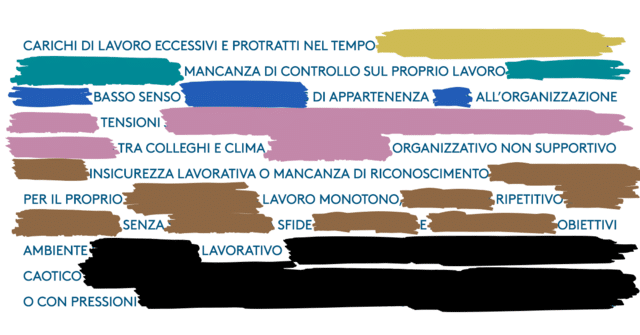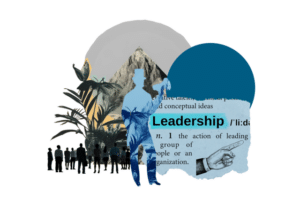Is your role good for you? Limits and balances to prevent burnout
When we speak of burnout, we very often think of overload, in most cases in the work field. The truth, however, is that burnout can be more a consequence of poor organization than of the amount of work to be done and that it is a sum of factors that includes both work and private life that harms our state of mind. Understanding how we are and what the priorities are for each of the roles that each of us plays in our daily lives also helps to recognize where we can draw a line so that we can live serenely in all the facets of which we are composed.
Stress: one (in two) of us
If there is one thing that workers all over the world have in common in this historical period, especially Millennials and Gen Z, it is a real stress emergency. The situation in our country is enough to understand how urgent it is to start thinking concretely about solutions: Bain & Company’s The Working Future research, which involved twenty thousand workers in ten different countries, gave Italy the record as the most stressed country in Europe, in which 64% of the under-35s interviewed declare that they feel under stress. Data also confirmed by the Gallup State of the Global Workplace report of 2022, which states that in Italy in the past year 49%, practically one out of two, of those interviewed declared feeling stressed, 16% feeling angry and 27% feeling sad (placing us in second place in Europe for this feeling, beaten only by Cyprus by one percentage point).
Looking at the continent as a whole, the percentage of people claiming to be stressed improves slightly, but still paints a rather worrying picture, as only 47% feel that their lives are emotionally and personally satisfying and flourishing. 37% say they experience worry daily (women and people under 40 are the main sufferers, 39% for both clusters) and 39% consider themselves to be stressed (up the average for those under 40 with 42% and women with 40%). It somewhat reassures the picture, however, to know that for 42% of Europeans, a salary allows them to live comfortably without worrying too much about finances (globally, the percentage drops to 22%).
To summarize all this data on a global scale, there is one fact to keep in mind that encapsulates why we can speak of a stress emergency: 2022 was the third year in a row in which a record was set in the percentage of workers in the world who experience stress daily, which rose to 44%.
These are numbers that make it clear that there is much to be done, both in terms of society as a whole and at a company level, to create a working environment in which mental well-being is protected and a better quality of life is possible. Not least because a lot of stress comes from work: a study by OSH tells us that in Europe 46% of respondents feel overwhelmed by excessive workload (especially women, 48% compared to 44% of men, and people with a permanent contract, 47% compared to 42% of those with a precarious contract and 44% of freelance workers), and even though about half of people recognize that steps are being taken to protect mental health in the company, such as information campaigns on the topic (in 59% of cases), talks with employees to check their stress level (43%), stress management courses (42%) and access to counseling or psychological support sessions (38%), 50% of respondents still believe that talking openly to their boss about mental health problems would harm their career. Although the average European percentage is high, reticence or fear of consequences in addressing these issues varies according to each country’s culture: in Italy, for example, the percentage rises to 63%. In our companies, little space is still given to pay attention to employees’ mental health and to share any problems that concern the sphere of emotional wellbeing; on the contrary, in Iceland, where conversations on this subject are more lively and more openly received, the percentage drops to 21%.
But is work, as stressful as it is, the only factor to take into account when talking about burnout?

Just like emotions, thoughts or, in a broader sense, life, our well-being does not work in watertight compartments: being unwell at work influences our private life, but also vice versa, in a continuous exchange of feelings, both positive and negative, that permeate our everyday life. This principle should be borne in mind when speaking of burnout: we often tend to look for the cause of burnout in the work (especially in its excess), losing sight of the fact that it is a holistic balance that influences a person’s psychophysical well-being, which includes, for example, the quality and quantity of leisure time, the ability to disconnect or family management.
Let us look at the main causes of Burnout:
- Excessive and prolonged workloads
- Lack of control over one’s work
- Low sense of belonging to the organization
- Tensions between colleagues and unsupportive organizational climate
- Job insecurity or lack of recognition for one’s work
- Monotonous, repetitive work or work without challenges and objectives appropriate to the person’s level of development
- Chaotic working environment or excessive pressure
Although they all refer to the work environment, they are easily translatable to situations in private life:
- Excessive family commitments and little time to complete them (such as child management)
- Lack of control over situations involving family members for whom one feels responsible (children, but also parents)
- Breakage or deterioration of an emotional bond (e.g. divorce)
- Lack of a sense of recognition of what one does during the day (e.g. housekeeping)
- Sense of annulment due to the load of commitments that makes one lose sight of who one really is
- Pressures and responsibilities that prevent effective organization of the day.
When an employee begins to show signs of severe stress, therefore, it may make sense not only to assess his or her working life, but to broaden one’s view of the personal situation as a whole and understand how one can help: preventing burnout has a lot to do with organization, as it is often not the workload and commitment that is wrong, but the way one manages it and tries to fit all the little pieces of the puzzle into the day that creates chaos.
To do this, it is important for companies to be able to support employees and collaborators by creating spaces for dialogue. Moments of sharing, such as feedback and feedforward meetings rather than coaching, should be valued and protected in identifying what the priorities, both work-related and personal, of each person are.
READ ALSO: FEEDBACK, FEEDFORWARD E COACHING CONVERSATION
The importance of role: where the job title ends and the person begins
Each of us plays several roles in the course of the day: that of an employee, a parent, a child, a husband or wife, a friend, a sports person or a reading enthusiast. However, it is not always easy, especially since it has become possible to work remotely, to close the door, even metaphorically, to separate what one is and does for work from everything else: yet knowing how to, on the one hand, understand and, on the other hand, maintain the right distance from one’s role or roles is essential to be able to carry on all facets of one’s daily life in a parallel and healthy manner.
READ ALSO: IL RUOLO – SAPERE USCIRNE È IMPORTANTE QUANTO SAPERLO INTERPRETARE
It is therefore important for each person to be aware of who one is in each situation, what feelings each role causes, and one’s tasks and responsibilities because in this way one can establish the right boundaries. A great help, especially for the youngest resources, who are the most prone to stress and consequent burnout, can also come from the managerial figures, who can become promoters of a more flexible and attentive culture to the mental health of employees.
Many aspects weigh on the psychological well-being of those in the 30-40 age bracket (in addition to the often very high workload, which in some cases is associated with contractual instability and a salary that does not reflect expectations, but also personal choices, such as whether to have a family or not, the consequences of the pandemic that are still being felt very strongly or the global situation from both a political and an environmental point of view) and a manager can provide valuable help both in recognizing the signs of burnout and in preventing it. In addition to constantly listening and observing the employees’ state of mind, a manager can help in spreading awareness of burnout risks, also by trying to counter toxic attitudes such as working overtime or on weekends. But he or she can make a difference above all in creating awareness of the roles that the people he or she works with live in, implementing with them a path to understanding how they are in those roles, what motivates them, what the priorities of each role are, to guide them in setting those limits that can protect them from mental and emotional overload.
The difference in finding a more balanced way of working that suits everyone’s needs, therefore, can be made by the very people who occupy the highest positions in the hierarchy, who dictate the rhythms and rules of the working environment.
Work-life integration: much more than work-life balance
Smart working has changed our lives in many ways, but one of its promises has not been (entirely) fulfilled: improving work-life balance. Research by McKinsey & Company shows that there is real stress from smart working, especially for those who play several roles during the day, such as parents or caregivers in general. The concept of work-life balance, therefore, understood as a balanced and equal division of work and private life, has proved almost entirely utopian.
The working model, after having changed drastically with the pandemic, is continuing to evolve, and this is why companies must now try to go a step further, implementing strategies that evolve the concept of work-life balance into work-life integration, i.e. integration of the two aspects with time optimization, people involvement and quality in the realization of projects as cornerstones. Work-life integration, therefore, is a way of enabling people to devote equal time and attention to all areas of their lives, without necessarily having to sacrifice one for the other.
The areas a company can work on to go in this direction are:
- Flexibility: in working hours and how colleagues interact with each other
- Attention to needs: allowing people to integrate work life differently for each person, based on both professional and personal commitments
- Planning also according to the biological clock: enables everyone to better coordinate work and private life
- More emphasis on productivity: it does not matter how many hours one works but how much one utilizes them. Focus on the value that is created rather than the hours spent at the computer
All these measures allow employees to juggle more comfortably and effectively between their various roles during the day, truly improving their mental well-being and quality of life and, consequently, preventing burnout.





